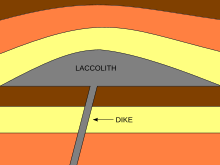Laccolith
A Lakkolith ( ancient Greek λάκκος Lakkos "pit cistern ") is in the geology of an upwardly bulging plutonic body having a substantially flat bottom. It consists of magma that has solidified at a shallow depth below the surface in the earth's crust , and has at least one supply channel leading into the depths, which is often fissure-shaped ( dyke ).
When taking the seat, the overlying rock was arched because the pressure of the overlying rock was lower than the pressure in the melt, so that Lakkolithe are concordant to the adjacent rock despite the arching . The rock has an acidic to intermediate composition.
The solidification depth lies between the igneous rocks on the surface (caused by volcanoes ) and the igneous rocks in the deep, the plutonites . Appearances of this kind belong to sub- volcanism (also deep volcanism and cryptovolcanism ).
A layer-bound and plate-shaped pluton without bulging of the overlying layers is called a storage corridor . If it is a solidified lava mass in the chimney of a volcano, this is called a chimney or diatrema.
See also
literature
- Rudolf Hohl (ed.): The history of the development of the earth . 6th edition. Werner Dausien Verlag, Hanau 1985, ISBN 3-7684-6526-8 , p. 200 f .
- Siegfried Matthes: Mineralogy . 3. Edition. Springer, Berlin, Heidelberg, New York 1990, ISBN 3-540-51912-2 , pp. 195 .
- Dietmar Reinsch: Natural stone studies. An introduction for civil engineers, architects, preservationists and stonemasons . Enke, Stuttgart 1991, ISBN 3-432-99461-3 , p. 101 .
- Dieter Richter: General Geology . 3. Edition. de Gruyter Verlag, Berlin - New York 1985, ISBN 3-11-010416-4 , pp. 270 .

